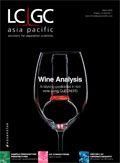ChloroFiltr® : A Novel Sorbent for Chlorophyll Removal
LCGC Asia Pacific
Application Note
Chlorophyll is one of the most problematic matrix co-extractives in pesticide residue analysis because of its non-volatile characteristics. When samples containing chlorophyll are injected into a gas chromatography (GC) system, chlorophyll accumulates in the GC inlet and GC column, causing active sites and affecting GC performance. Graphitized carbon black (GCB) is widely used to remove chlorophyll from fruit and vegetable samples. However, GCB will strongly adsorb planar pesticides, such as carbendazim and thiabendazole, resulting in low recoveries. To resolve this issue, UCT has invented a novel sorbent, ChloroFiltr®, to remove chlorophyll from QuEChERS extracts without sacrificing the recovery of planar pesticides. ChloroFiltr® should not be used for mycotoxin analysis.
QuEChERS Extraction
1. Weigh 10 g of homogenized spinach sample into a 50-mL centrifuge tube (ECPAHFR50CT).
2. Spike with 100 μL of 50 ppm triphenyl phosphate internal standard.
3. Vortex for 30 s and equilibrate for 15 min.
4. Add 10 mL of acetonitrile, shake for 1 min.
5. Add salts in Mylar pouch (ECQUUS2-MP), shake vigorously for 1 min.
6. Centrifuge at 5000 rpm for 5 min. The supernatant is ready for cleanup.

Extraction and Clean-up Materials
dSPE Cleanup
1. Transfer 1 mL supernatant into a 2-mL dSPE tube (with ChloroFiltr® or GCB), shake for 30 s.
2. Centrifuge at 10,000 rpm for 5 min.
3. Transfer 0.4 mL of the cleaned extract into a 2-mL autosampler vial.
4. The sample is ready for liquid chromatography tandem mass spectrometry (LC–MS–MS) analysis.

Figure 1: Crude spinach extract (a) cleaned with ChloroFiltr® (b) is less green than that cleaned with graphitized carbon black (GCB) (c), indicating that ChloroFiltr® is more efficient in chlorophyll clean-up.
LC–MS–MS parameters and multiple reaction monitoring (MRM) transitions are available upon request.
Results
The recoveries of carbendazim, thiabendazole, pyrimethanil and cyprodinil were adversely affected by GCB, especially thiabendazole with a much lower recovery of 55.9% compared to 93.2% obtained by ChloroFiltr®. Diazinon, pyrazophos and chlorpyrifos were less or not affected by GCB because of the non-planar side chains in their structures.

Table 1: Comparison of pesticide recoveries and RSDs obtained by dSPE clean-up of spinach sample using ChloroFiltr® and GCB (n = 4).
Conclusion
ChloroFiltr®, a novel sorbent, is found capable of removing chlorophyll efficiently without affecting the recoveries of planar pesticides. ChloroFiltr® offers a successful substitute for GCB in chlorophyll removal.
UCT, LLC
2731 Bartram Road, Bristol, Pennsylvania 19007, USA
tel. 800.385.3153
Email: methods@unitedchem.com
Website: www.unitedchem.com

HPLC 2025 Preview: Fundamentally Speaking (Part 1)
May 13th 2025Michael Lämmerhofer from the Institute of Pharmaceutical Sciences, University of Tübingen, Germany, spoke to JFK Huber Lecture Award winner of 2024 Torgny Fornstedt, professor in analytical chemistry and leader of the Fundamental Separation Science Group, Karlstad University, Sweden, about his pioneering work in high performance liquid chromatography (HPLC) with a focus on fundamentals and industrial applications.
Reversed-Phases for LC Deliberately Doped with Positive Charge: Tips and Tricks for Effective Use
May 13th 2025In this month's edition of LC Troubleshooting, Dwight Stoll and his fellow researchers discuss both the benefits (improved peak shape/loading) and challenges (excessive interaction) associated with charge-doped reversed-phase (RP) columns for both analytical and preparative separations.
Determining Ways to Protect Honeybee Colonies with GC–MS
May 13th 2025A study conducted by the Agriculture Research Centre of Giza, Egypt, and Jilin Agricultural University in China, evaluated the efficacy of stinging nettle extract, nettle smoke, and formic acid in the controlling of Varroa mites, a major threat to honeybee colonies, with a focus on mite infestation reduction, honeybee mortality, and biochemical responses. Gas chromatography–mass spectrometry (GC–MS) was used to identify key bioactive compounds in the stinging nettle extract.

.png&w=3840&q=75)

.png&w=3840&q=75)



.png&w=3840&q=75)



.png&w=3840&q=75)










